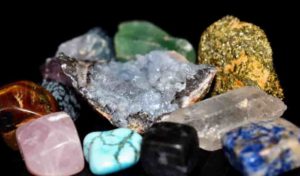
What is Metamorphic rock?
Metamorphic rocks arise from the transformation of existing rock types, in a process called metamorphism, which means “change in form”. The original rock (protolith) is subjected to heat (temperatures greater than 150 to 200 °C) and pressure (100 megapascals (1,000 bar) or more), causing profound physical or chemical change. The protolith may be a sedimentary, igneous, or existing metamorphic rock.
Metamorphic rocks make up a large part of the Earth’s crust and form 12% of the Earth’s land surface. They are classified by texture and by chemical and mineral assemblage (metamorphic facies). They may be formed simply by being deep beneath the Earth’s surface, subjected to high temperatures and the great pressure of the rock layers above it. They can form from tectonic processes such as continental collisions, which cause horizontal pressure, friction and distortion. They are also formed when rock is heated by the intrusion of hot molten rock called magma from the Earth’s interior. The study of metamorphic rocks (now exposed at the Earth’s surface following erosion and uplift) provides information about the temperatures and pressures that occur at great depths within the Earth’s crust. Some examples of metamorphic rocks are gneiss, slate, marble, schist, and quartzite.
Metamorphic Cycle
The metamorphic cycle is the third largest cycle in mineral and rock formation. Metamorphism is the alteration of mineral paragenesis (the order of formation) after their deposition, by external action such as contact with magmetic rocks, regional changes in the pressure and temperature (e.g. contact metamorphosed limestones, crystalline schists, etc.). The consolidated rocks are altered in composition, texture or internal structure through pressure, heat and new chemical substances.
There are two kinds of metamorphism: Regional and Contact
- Regional metamorphism is caused due to a rise in temperature and directed pressure, effecting the earth’s crust.
- Contact metamorphism is caused when magma is intruded into a preexisting rock mass. The heat and pressure of this magma, causes a metamorphic change in the rock it intrudes.
Both igneous and sedimentary rocks can change in texture or chemical composition as the result of either contact or regional metamorphism. Thus existing rocks change into new types of rocks. They are usually harder and denser than the original material.
For example, shale may alter into slate and further metamorphose into schist. Limestone is converted into marble. Sometimes schists contain gem minerals like garnet, emerald and corundum.
Some minerals that grow in metamorphic rocks are:
- Beryl
- Corundum
- Danburite
- Garnets
- Iolite
- Lapis lazuli
- Jadeite
- Nephrite
- Spinel
- Alexandrite
- Andalusite
Reference:
Metamorphic rock
Metamorphic rocks










